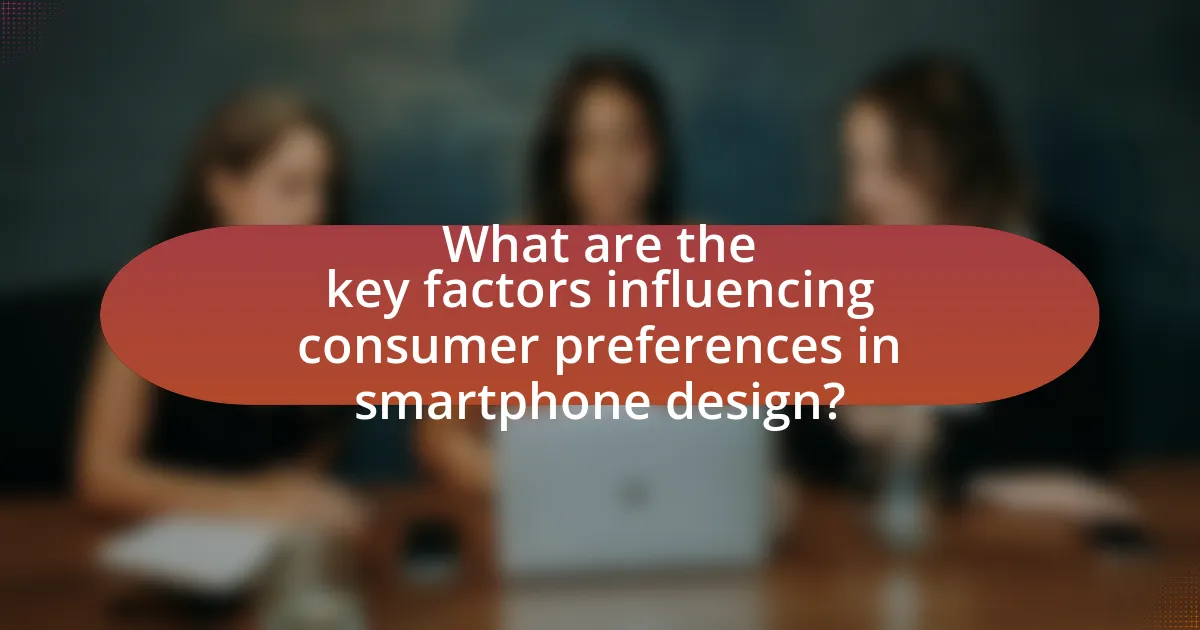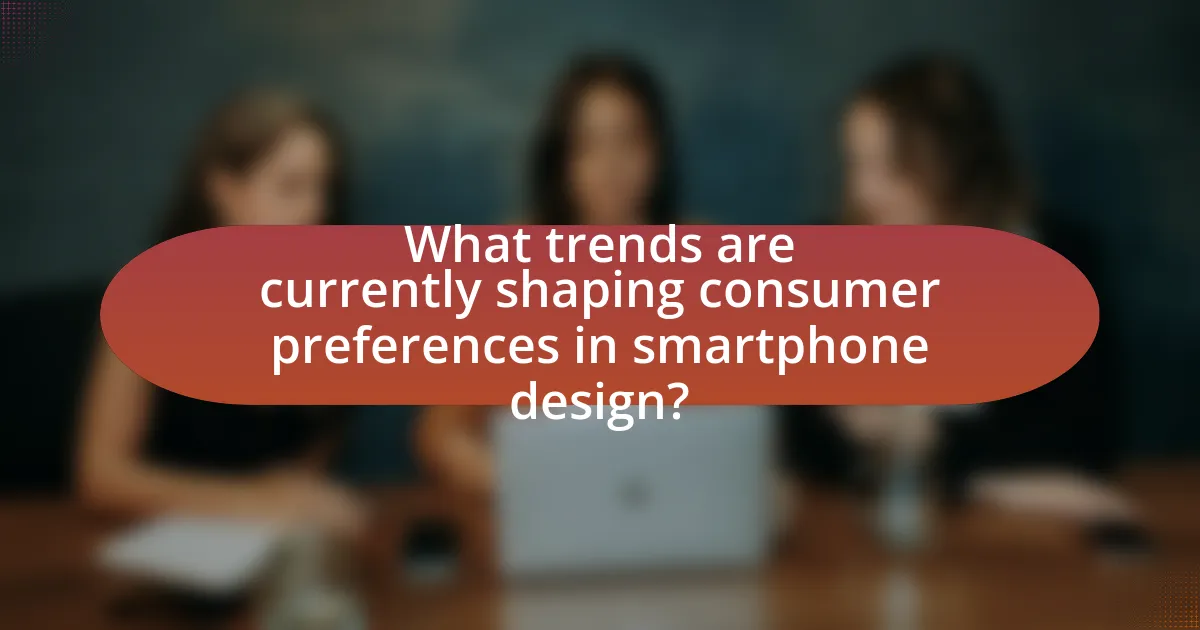The article focuses on analyzing consumer preferences in smartphone design, highlighting key factors such as aesthetics, functionality, brand reputation, and price. It discusses how design elements like color, simplicity, and material choice impact consumer attraction and satisfaction. The role of functionality, including camera quality and battery life, is emphasized as a critical determinant in purchasing decisions. Additionally, the article explores the influence of brand reputation and loyalty on consumer choices, as well as current trends like sustainability and technological advancements, including 5G, that shape consumer expectations in the smartphone market. Various methodologies for analyzing consumer preferences, including surveys and focus groups, are also examined to provide insights into effective design alignment with consumer needs.

What are the key factors influencing consumer preferences in smartphone design?
The key factors influencing consumer preferences in smartphone design include aesthetics, functionality, brand reputation, and price. Aesthetics, such as color, shape, and materials, significantly impact consumer attraction, as studies show that visually appealing designs can enhance perceived value. Functionality, including features like camera quality, battery life, and user interface, directly affects usability and satisfaction, with research indicating that consumers prioritize these aspects when making purchasing decisions. Brand reputation plays a crucial role, as established brands often benefit from consumer trust and loyalty, influencing preferences based on perceived quality and reliability. Lastly, price sensitivity varies among consumers, with many willing to pay a premium for perceived value, while others seek budget-friendly options, demonstrating the importance of cost in decision-making.
How do aesthetics impact consumer choices in smartphone design?
Aesthetics significantly influence consumer choices in smartphone design by affecting perceptions of quality and desirability. Research indicates that visually appealing designs can enhance user satisfaction and brand loyalty, as consumers often associate attractive aesthetics with superior functionality and innovation. For instance, a study published in the Journal of Consumer Research found that products with sleek, modern designs are perceived as more valuable, leading to higher purchase intentions. This correlation between aesthetics and consumer behavior underscores the importance of design elements such as color, shape, and material in shaping consumer preferences in the competitive smartphone market.
What design elements are most appealing to consumers?
The design elements most appealing to consumers include simplicity, color, and functionality. Simplicity in design enhances user experience by making interfaces intuitive and easy to navigate, which is supported by studies showing that 76% of consumers prefer a simple design. Color plays a crucial role in attracting attention and influencing emotions; for instance, research indicates that color can increase brand recognition by up to 80%. Functionality, which encompasses the usability and performance of the device, is essential, as 70% of consumers prioritize functionality over aesthetics when choosing a smartphone. These elements collectively contribute to consumer satisfaction and purchasing decisions in smartphone design.
How does color and material choice affect consumer perception?
Color and material choice significantly influences consumer perception by affecting emotional responses and perceived product quality. Research indicates that colors evoke specific feelings; for example, blue is often associated with trust and reliability, while red can evoke excitement and urgency. Additionally, materials such as metal or glass are perceived as more premium compared to plastic, impacting consumers’ judgments about the product’s value. A study published in the Journal of Consumer Research by Labrecque and Milne (2013) found that congruence between color and material enhances brand perception, leading to increased consumer preference and purchase intention. Thus, strategic selection of color and material can enhance consumer attraction and loyalty in smartphone design.
What role does functionality play in consumer preferences?
Functionality significantly influences consumer preferences by determining the usability and effectiveness of a smartphone. Consumers prioritize features that enhance their daily tasks, such as camera quality, battery life, and processing speed. Research indicates that 70% of smartphone buyers consider functionality as a key factor in their purchasing decisions, highlighting its critical role in shaping preferences. This emphasis on functionality drives manufacturers to innovate and improve their products to meet consumer demands, ultimately affecting market trends and competition.
Which features do consumers prioritize when selecting a smartphone?
Consumers prioritize camera quality, battery life, and performance when selecting a smartphone. Research indicates that 48% of consumers consider camera capabilities as the most important feature, followed by 30% prioritizing battery life and 22% focusing on overall performance. These preferences are driven by the increasing demand for high-quality photography, extended usage without frequent charging, and smooth operation for multitasking and gaming.
How do usability and ergonomics influence consumer satisfaction?
Usability and ergonomics significantly influence consumer satisfaction by enhancing the overall user experience and comfort during product interaction. When smartphones are designed with intuitive interfaces and ergonomic features, users find them easier to operate, leading to increased satisfaction. Research indicates that products with high usability can improve user retention rates by up to 50%, as consumers are more likely to continue using devices that feel comfortable and are easy to navigate. Furthermore, ergonomic design reduces physical strain, which is crucial for prolonged use, thereby fostering a positive emotional connection with the product. This connection is supported by studies showing that 70% of consumers prioritize comfort and ease of use when selecting a smartphone, directly linking these factors to their overall satisfaction.
How does brand reputation affect consumer preferences in smartphone design?
Brand reputation significantly influences consumer preferences in smartphone design by shaping perceptions of quality, innovation, and reliability. Consumers often associate well-established brands with superior design features, leading them to prefer smartphones from these brands over lesser-known competitors. For instance, a study by Nielsen found that 59% of consumers prefer to buy products from brands they trust, indicating that brand reputation directly impacts purchasing decisions. Additionally, brands with strong reputations can command premium pricing, as consumers are willing to pay more for perceived value, further reinforcing their design choices.
What impact does brand loyalty have on design choices?
Brand loyalty significantly influences design choices by guiding companies to create products that resonate with their established customer base. When consumers are loyal to a brand, they expect design elements that reflect the brand’s identity, values, and aesthetics, which can lead to a more cohesive product line. For instance, Apple’s consistent design language across its devices fosters a sense of familiarity and trust among its loyal customers, reinforcing their preference for future products. Research indicates that 70% of consumers are more likely to purchase from brands they are loyal to, highlighting the importance of aligning design choices with consumer expectations to maintain loyalty and drive sales.
How do marketing strategies shape consumer perceptions of smartphone design?
Marketing strategies significantly shape consumer perceptions of smartphone design by influencing brand image, highlighting features, and creating emotional connections. For instance, companies like Apple utilize sleek advertising and premium branding to position their smartphones as high-status items, which affects consumer perceptions of design quality and desirability. Research indicates that 64% of consumers make purchasing decisions based on brand perception, underscoring the impact of marketing on consumer views. Additionally, targeted campaigns that emphasize innovative design elements, such as camera quality or screen resolution, can lead consumers to associate these features with superior design, thereby altering their preferences and expectations.

What trends are currently shaping consumer preferences in smartphone design?
Current trends shaping consumer preferences in smartphone design include a demand for minimalistic aesthetics, enhanced durability, and sustainable materials. Consumers increasingly favor sleek, lightweight designs that prioritize functionality while maintaining visual appeal. Additionally, there is a growing preference for devices with improved water and dust resistance ratings, reflecting a desire for longevity and reliability. Sustainability is also a significant factor, with many consumers opting for smartphones made from recycled materials or those that support eco-friendly practices. According to a 2023 survey by Statista, 70% of consumers consider sustainability an important factor in their purchasing decisions, highlighting the impact of these trends on the market.
How is the rise of sustainability influencing smartphone design choices?
The rise of sustainability is significantly influencing smartphone design choices by prompting manufacturers to prioritize eco-friendly materials and energy-efficient technologies. Companies are increasingly using recycled materials, such as aluminum and plastics, in their devices; for instance, Apple has committed to using 100% recycled aluminum in certain models. Additionally, the design process now often incorporates modular components, allowing for easier repairs and upgrades, which extends the device’s lifespan and reduces electronic waste. Research indicates that 70% of consumers are willing to pay more for sustainable products, highlighting the market demand for environmentally responsible design.
What materials are consumers looking for in eco-friendly smartphones?
Consumers are looking for materials such as recycled metals, biodegradable plastics, and sustainable glass in eco-friendly smartphones. These materials are preferred because they reduce environmental impact and promote sustainability. For instance, a study by the International Telecommunication Union found that using recycled metals can significantly lower carbon emissions associated with smartphone production. Additionally, biodegradable plastics help minimize waste in landfills, aligning with consumer demand for products that are less harmful to the environment.
How do consumers perceive brands that prioritize sustainability in design?
Consumers generally perceive brands that prioritize sustainability in design positively, associating them with ethical responsibility and innovation. Research indicates that 66% of global consumers are willing to pay more for sustainable brands, reflecting a strong preference for environmentally conscious practices. Brands like Apple and Samsung, which incorporate sustainable materials and processes, often enhance their reputation and customer loyalty, as consumers increasingly value sustainability in their purchasing decisions.
What technological advancements are affecting consumer preferences?
Technological advancements such as artificial intelligence, 5G connectivity, and augmented reality are significantly affecting consumer preferences in smartphone design. Artificial intelligence enhances user experience through personalized recommendations and improved camera functionalities, making devices more appealing. The rollout of 5G connectivity allows for faster data transfer and improved streaming capabilities, leading consumers to prefer smartphones that support this technology. Additionally, augmented reality features enable immersive experiences in gaming and shopping, influencing consumers to choose smartphones that offer these capabilities. According to a report by Deloitte, 5G adoption is expected to drive a 30% increase in smartphone sales by 2025, highlighting the impact of these advancements on consumer choices.
How do innovations in display technology influence design preferences?
Innovations in display technology significantly influence design preferences by enhancing visual quality and user experience. For instance, advancements such as OLED and AMOLED displays provide deeper blacks and more vibrant colors, leading consumers to prefer devices that showcase these technologies. Research indicates that 70% of consumers prioritize display quality when selecting smartphones, demonstrating a direct correlation between display innovations and consumer choices. Furthermore, features like edge-to-edge screens and higher refresh rates have shifted design trends towards sleeker, more immersive devices, as consumers increasingly seek aesthetics that complement enhanced display capabilities.
What role do camera features play in consumer decision-making?
Camera features significantly influence consumer decision-making by directly impacting perceived value and usability of smartphones. High-quality camera specifications, such as megapixel count, optical zoom, and low-light performance, are often prioritized by consumers, as these features enhance photography experiences. Research indicates that 48% of consumers consider camera quality the most important factor when purchasing a smartphone, highlighting its critical role in influencing buying choices. Additionally, advancements in camera technology, such as AI enhancements and multiple lens systems, further attract consumers seeking superior photography capabilities, thereby shaping their purchasing decisions.
How are consumer preferences evolving with the introduction of 5G technology?
Consumer preferences are evolving towards higher demand for faster connectivity and enhanced mobile experiences with the introduction of 5G technology. As 5G networks offer significantly increased data speeds, lower latency, and improved reliability, consumers are prioritizing smartphones that can fully leverage these capabilities. According to a survey by Deloitte, 61% of consumers expressed interest in upgrading to 5G-enabled devices, highlighting a shift in preference towards devices that support advanced features such as augmented reality, high-definition streaming, and seamless gaming experiences. This trend indicates that consumers are increasingly valuing performance and functionality in their smartphone choices, driven by the enhanced possibilities that 5G technology provides.
What design changes are being made to accommodate 5G capabilities?
Smartphone manufacturers are implementing several design changes to accommodate 5G capabilities, including the integration of advanced antenna systems, enhanced thermal management solutions, and modifications to device dimensions. These changes are necessary because 5G technology requires more antennas to support higher frequencies and increased data throughput, leading to the adoption of multi-band antennas that can fit within the compact design of smartphones. Additionally, improved thermal management is essential to dissipate heat generated by the more powerful processors and components needed for 5G connectivity. For instance, companies like Samsung and Apple have redesigned their internal layouts to optimize space for these components while maintaining user-friendly aesthetics and ergonomics.
How do consumers perceive the value of 5G in smartphone design?
Consumers perceive the value of 5G in smartphone design as a significant enhancement that influences their purchasing decisions. The integration of 5G technology is associated with faster data speeds, improved connectivity, and enhanced user experiences, which consumers find appealing. According to a survey by Deloitte, 61% of consumers indicated that 5G capability is an important factor when choosing a smartphone, highlighting its perceived value in modern design. This perception is further supported by the expectation that 5G will enable advanced applications such as augmented reality and high-definition streaming, making it a critical feature in the evolving landscape of smartphone technology.

What methodologies can be used to analyze consumer preferences in smartphone design?
Surveys and focus groups are effective methodologies to analyze consumer preferences in smartphone design. Surveys allow for the collection of quantitative data from a large sample, enabling researchers to identify trends and preferences regarding features such as screen size, battery life, and camera quality. Focus groups provide qualitative insights by facilitating discussions among selected participants, revealing deeper motivations and emotional responses to design elements. Research indicates that combining these methodologies enhances understanding; for instance, a study published in the Journal of Consumer Research demonstrated that integrating qualitative insights from focus groups with quantitative survey data leads to more robust consumer preference analysis.
How can surveys and questionnaires effectively gather consumer insights?
Surveys and questionnaires effectively gather consumer insights by systematically collecting data on preferences, behaviors, and attitudes. These tools allow researchers to reach a broad audience, ensuring diverse input that reflects various consumer segments. For instance, a study by the Pew Research Center found that online surveys can yield high response rates, with 70% of participants completing them when incentivized appropriately. This high engagement level enhances the reliability of the insights gathered, enabling companies to make informed decisions regarding smartphone design that align with consumer expectations.
What types of questions yield the most valuable data on preferences?
Closed-ended questions yield the most valuable data on preferences, as they provide quantifiable insights into consumer choices. These questions typically offer predefined answer options, such as multiple-choice or rating scales, allowing for easier analysis and comparison of responses. Research indicates that closed-ended questions can lead to higher response rates and clearer data patterns, making them effective for understanding specific consumer preferences in smartphone design. For instance, a study by Dillman et al. (2014) in “Internet, Phone, Mail, and Mixed-Mode Surveys: The Tailored Design Method” demonstrates that structured questions enhance data reliability and validity, particularly in market research contexts.
How can demographic factors influence survey results?
Demographic factors can significantly influence survey results by affecting respondents’ perceptions, preferences, and behaviors. For instance, age can determine technology familiarity, with younger individuals often favoring innovative features in smartphone design, while older demographics may prioritize usability and simplicity. Gender differences can also play a role; studies have shown that men and women may have varying preferences for smartphone aesthetics and functionality. Additionally, income levels can impact purchasing decisions, as higher-income individuals may lean towards premium models with advanced features, while lower-income respondents might prioritize affordability. Research indicates that these demographic variables can lead to distinct patterns in consumer preferences, ultimately shaping the overall survey outcomes in the context of smartphone design.
What role do focus groups play in understanding consumer preferences?
Focus groups play a critical role in understanding consumer preferences by facilitating direct interaction between consumers and researchers, allowing for in-depth insights into attitudes, motivations, and behaviors. This qualitative research method enables companies to gather nuanced feedback on product features, design elements, and overall user experience, which is essential in the competitive smartphone market. For instance, a study by the American Marketing Association found that focus groups can reveal consumer desires that quantitative surveys may overlook, such as emotional connections to brand aesthetics. This information helps companies tailor their smartphone designs to better meet consumer expectations and enhance market appeal.
How can focus group discussions reveal deeper insights into design preferences?
Focus group discussions can reveal deeper insights into design preferences by facilitating interactive dialogue among participants, allowing for the exploration of their thoughts and feelings about design elements. This method encourages participants to express their opinions, share experiences, and build on each other’s ideas, leading to a richer understanding of consumer preferences. Research indicates that qualitative data gathered from focus groups can uncover nuanced insights that quantitative surveys may overlook, such as emotional responses to design features or the significance of aesthetic elements in user experience. For instance, a study by Krueger and Casey (2015) highlights that focus groups can identify specific design attributes that resonate with users, providing designers with actionable feedback to enhance product development.
What are the limitations of using focus groups for this analysis?
Focus groups have several limitations for analyzing consumer preferences in smartphone design. Firstly, the small sample size often leads to non-representative results, as the opinions of a few individuals may not reflect the broader consumer base. Additionally, group dynamics can influence individual responses, causing some participants to conform to dominant opinions rather than express their true preferences. Furthermore, focus groups may suffer from moderator bias, where the facilitator’s leading questions can skew the discussion and outcomes. Lastly, the qualitative nature of focus group data can make it challenging to quantify preferences accurately, limiting the ability to generalize findings to the larger market.
What data analysis techniques can be applied to consumer preference studies?
Data analysis techniques applicable to consumer preference studies include surveys, conjoint analysis, cluster analysis, and sentiment analysis. Surveys gather quantitative data on consumer preferences, allowing for statistical analysis of trends and patterns. Conjoint analysis helps determine how consumers value different attributes of a product by presenting them with various combinations of features. Cluster analysis groups consumers based on similar preferences, enabling targeted marketing strategies. Sentiment analysis evaluates consumer opinions expressed in social media or reviews, providing insights into brand perception and preference. These techniques are validated by their widespread use in market research, demonstrating their effectiveness in understanding consumer behavior.
How can qualitative and quantitative data be integrated for comprehensive insights?
Qualitative and quantitative data can be integrated for comprehensive insights by employing mixed-methods research, which combines numerical data analysis with thematic interpretation. This approach allows researchers to validate quantitative findings through qualitative insights, enhancing the understanding of consumer preferences in smartphone design. For instance, a study may utilize surveys to gather quantitative data on consumer satisfaction ratings while conducting focus groups to explore the reasons behind those ratings. This integration provides a fuller picture, as quantitative data reveals trends and patterns, while qualitative data offers context and depth, leading to more informed design decisions.
What tools are available for analyzing consumer preference data?
Tools available for analyzing consumer preference data include survey platforms, statistical analysis software, and data visualization tools. Survey platforms like Qualtrics and SurveyMonkey enable researchers to gather consumer feedback efficiently. Statistical analysis software such as SPSS and R allows for in-depth analysis of preference data, including regression analysis and factor analysis. Data visualization tools like Tableau and Power BI help in presenting the analyzed data in an understandable format, facilitating insights into consumer preferences. These tools are widely used in market research to derive actionable insights from consumer data.
What best practices should companies follow to align smartphone design with consumer preferences?
Companies should conduct thorough market research to align smartphone design with consumer preferences. This involves utilizing surveys, focus groups, and user feedback to understand consumer needs and desires. For instance, a study by Deloitte in 2021 found that 70% of consumers prioritize battery life and camera quality when selecting a smartphone. By integrating these insights into the design process, companies can create products that resonate with their target audience. Additionally, companies should adopt iterative design practices, allowing for continuous improvement based on user testing and feedback, which has been shown to enhance user satisfaction and loyalty.




